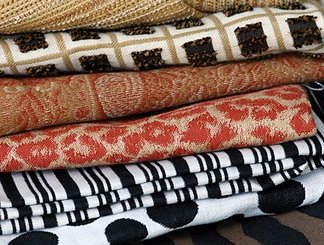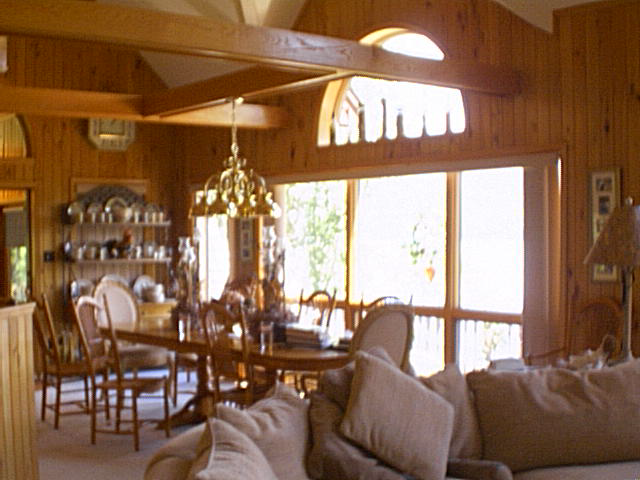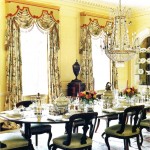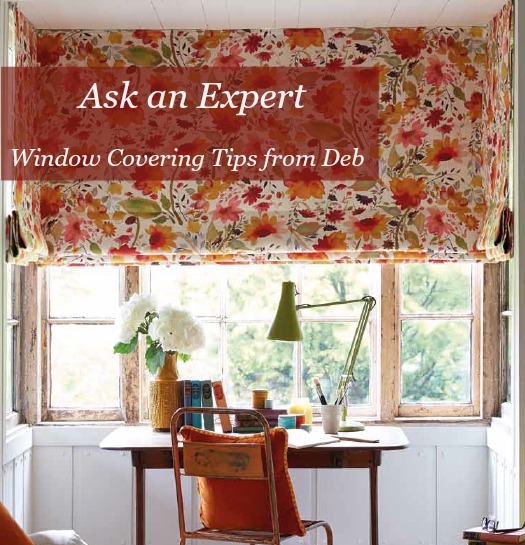

I like to think of myself as an expert and all around window fashion maven who believes in sharing with her peers and clients. My skill is not only in the technology of window treatments, but in combining design with the details to make the end result stunning.
If you have a dilemma, situation you need to vent about, or a burning question submit it here and I’ll be happy to give it my best shot. 
ASK AN EXPERT

Hello Deb,
I am hoping you can help me. I’m ordering drapery panels and I am trying to determine what length rod to buy for the appropriate stack back. My window is 77″ wide (including trim) and my panels will total 88″. They are double width, Parisian pleat, blackout lined linen. The two options I am weighing are:
- French rod 92″ wide with 3″ return on both sides.
- Standard pole (was thinking 96″)
Thank you!

I need more information please. Are these stationary panels? Or do you want them to function? What is the 88″ measure? Is it the finished width of the drapery (measure at top once pleats are sewn in from edge to edge) at top of the PAIR OR EACH panel? You mentioned that the two options you are weighing are:
- French rod 92″ wide with 3″ return on both sides. That means the rod is 7.5″ out from each side of trim
- Standard pole (was thinking 96″) There is no such thing as a standard pole- 96″ will be out 9.5 inches from trim each side
Until I know if you want these to function and what the finished width is can’t figure rod face width. If the finished width of the PAIR is 88″ and you want them to function; then you have deduct 6″ for the returns and another 7″ for overlaps of the leading edges and that means your bracket- to- bracket measure of the rod should be 75″ – which is less than your window. So, your draperies are not wide enough for window.

They are not stationary panels, but they also will not be used often. 88” is the finished width of both panels (each 44” not including return). Thank you so much for your honesty and insight – very much appreciated! I think I’ll consider going with the 55” panels then since that’ll give me 110” overall. Do you think a 108” rod would be okay or should I go with a 102” instead?
Ok- so just so you know they will not close completely. Also, I am not sure why your measures don’t include returns, but my suggestion is the smallest French pole you can order to fit the window . I guess that would be your 92″ option. I would go with 92″ or 96″ pole as return measures are always included in the finished width measure so that means your panels hung across the rod will measure 92″ because of overlap – less returns.

Good afternoon Deb,
 Do you think pinch pleat drapery will work on these rods? The client wants traversing inverted box pleated panels as well. I do not think that would work at all, what do you think?
Do you think pinch pleat drapery will work on these rods? The client wants traversing inverted box pleated panels as well. I do not think that would work at all, what do you think?
Thanks for the help,
Anne Keane

The biggest problem is that the inverted pleat when traversing does not stack well and has to be redressed often and will not hang in folds like a euro or pinch pleat. The pin for these has to be at top of panel making it even more of an issue.

Hi Deb,
I was wondering if you can help me with a window treatment question or can direct me to someone who can. I had some functional panels made (see attached picture), they are 3 widths each, with a soft blackout lining. The client took them to their beach condo, hung them and loved them. Now about four months later they are complaining that they are flaring out towards the bottom and not keeping its pleats. She brought them back to see what we can do and we are not sure, they still have all the fold marks as if they were still keeping the folds, so not sure why they are flaring. The only thing I can think about is humidity?? If that was the case, do you know if there is any spray I could use to “seal” the fabric? Have also thought of adding the beaded chain in the back but hesitant- a lot of labor and not sure how well it works on functional panels.
Any thoughts? Or do you know of anyone that would have any ideas?
Thanks!!
Eleida, Next Level Interiors


The flaring can be created from several things- I don’t know if humidity is a major factor, but salt air environment could. Though I really doubt it. Usually it is caused by fiber content. Polyesters are notorious and when mixed with linings that are majority of polyester the linings pull away from the face fabric and the also flare. My suggestion is to definitely use the memory stitch on the back it controls the pleat from flaring and twisting. I would also suggest that you steam them prior to doing memory stitch so folds are rounded and full- from pic it looks like the folds are not .
Hope this helps.
Deb

I have 95″ wide window with 36″ on each side. need to know the stack back for each side if I were to make drapery 125″ wide. Would like to clear window but doesn’t need to be totally clearing window. Thanks for your help. Been a long time since I figured pinch pleat drapery that will traverse with split draw!!
 I have been asked this question a lot lately, now that stationery panels seem to be giving way to traversing looks. Stackback is based fabric weight, linings, pleat type and rod selection so it is not a exact science. A stackback measure also needs to be divided in half if using pairs. If you are using blackout lining so stack back will increase a bit. If your measure provided of 125″ is a bracket to bracket measure width your stackback is approximately 37″ or 18.5″ on each side and will leave an opening of about 88″.
I have been asked this question a lot lately, now that stationery panels seem to be giving way to traversing looks. Stackback is based fabric weight, linings, pleat type and rod selection so it is not a exact science. A stackback measure also needs to be divided in half if using pairs. If you are using blackout lining so stack back will increase a bit. If your measure provided of 125″ is a bracket to bracket measure width your stackback is approximately 37″ or 18.5″ on each side and will leave an opening of about 88″.
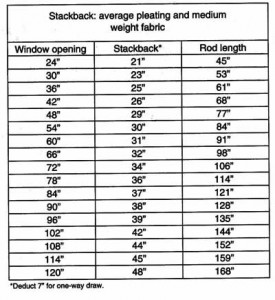
_________________________________________________________________________________________
 I have a customer that likes the look of a sheer, but needs a bit more privacy so I was thinking of having it lined. Have you ever done a lined sheer? Did it look OK? How was the hem finished?
I have a customer that likes the look of a sheer, but needs a bit more privacy so I was thinking of having it lined. Have you ever done a lined sheer? Did it look OK? How was the hem finished?
 Not knowing how much privacy your client needs; doing a lined sheer could solve the issue. I would get more specific with the customer before selling her anything. How much privacy? how often? what specifically is it she likes about the sheer? softness, ethereal light? etc. Then decide if a lined sheer is the best option. If you line it- FIRST consider self lining it – using the same sheer as the lining. Then make it fuller than usual ( 3 x or 3.5 x)- that will add more fabric and more privacy- If that doesn’t gives her the privacy she needs; then before lining it with a lining fabric. I would try to sell her a hard treatment she can hide behind the sheer and pull down when she needs privacy OR sell her over draperies she can draw for privacy and leave the sheer stationery behind for that soft, ethereal look. Mockups might have to be done so she can visualize. This is where you get yardage to replicate.
Not knowing how much privacy your client needs; doing a lined sheer could solve the issue. I would get more specific with the customer before selling her anything. How much privacy? how often? what specifically is it she likes about the sheer? softness, ethereal light? etc. Then decide if a lined sheer is the best option. If you line it- FIRST consider self lining it – using the same sheer as the lining. Then make it fuller than usual ( 3 x or 3.5 x)- that will add more fabric and more privacy- If that doesn’t gives her the privacy she needs; then before lining it with a lining fabric. I would try to sell her a hard treatment she can hide behind the sheer and pull down when she needs privacy OR sell her over draperies she can draw for privacy and leave the sheer stationery behind for that soft, ethereal look. Mockups might have to be done so she can visualize. This is where you get yardage to replicate.
Also, remember when you self line with a sheer you will get a moire effect( like a watermark) so be sure to tell the customer.
 Did you not at one time publish some info on crinoline size versus hems in draperies? Is there a chart somewhere?
Did you not at one time publish some info on crinoline size versus hems in draperies? Is there a chart somewhere?
 Thanks for the question. I do not have a chart, but regularly talk about designers specifying deeper headers on draperies and top treatments; especially when panels are over 90″. There is no rule that headers should be 4″; I suggest increasing the depth to 6″ for any panel over 88”( BTW Goblet pleats look great deeper) . If you are looking for buckram for your deeper headers try Rowley Company or your local upholstery supply house and ask them to cut sofa skirting to the size you need.
Thanks for the question. I do not have a chart, but regularly talk about designers specifying deeper headers on draperies and top treatments; especially when panels are over 90″. There is no rule that headers should be 4″; I suggest increasing the depth to 6″ for any panel over 88”( BTW Goblet pleats look great deeper) . If you are looking for buckram for your deeper headers try Rowley Company or your local upholstery supply house and ask them to cut sofa skirting to the size you need.
I also regularly specify our hems to be 10″ double folded to 5”- panels seem to hang better.
Deb
__________________________________________________________________________________________

Hi Deb,
This may sound funny, but when you do mood boards for a customer, do you give them to the client as a rule?
 If the board is part of the arrangement you have with her- yes.( Meaning- if I told her that I would provide her with a moodboard as part of my service and she paid for them.) I wouldn’t give them to her if you did a consult gratis and/or didn’t build the design time into your fees. Also, you might want to consider her signing off on the board as some designers do for sketches/ boards/drawings:
If the board is part of the arrangement you have with her- yes.( Meaning- if I told her that I would provide her with a moodboard as part of my service and she paid for them.) I wouldn’t give them to her if you did a consult gratis and/or didn’t build the design time into your fees. Also, you might want to consider her signing off on the board as some designers do for sketches/ boards/drawings:
Drawings, specifications, and sample boards, as instruments of service, are the property of the designer. The designer reserves the exclusive copyright to these items and provides them to you for your use on this project only. Any reproduction or reuse of the drawings, specifications, and sample boards without prior written permission is not permitted.
We shall retain ownership of design, including any drawings, renderings, sketches, samples or other materials prepared by us during the course of the project. Our ownership shall include all copyrights, trademarks, or proprietary rights existing in the design. You shall not use the design for any other project without asking our permission and paying compensation.
These designs shall remain the property of (Company) and cannot be transferred, sold or shared with any other designer, workroom, decorator, retail store or any other person without the expressed written consent of (Company Name)
_________________________________________________________________________________________

Hi Deb,
I have an interesting dilemma for outside drapery panels. I have a client that lives on Lake WA and wants replaced his existing (decrepit) drapes. The problem I have is that even with tie downs the drapes blow in the wind so badly. Do you have any advice about what I can put in the hem that will hold them down? The fabricator said to buy chains from Lowes cut to the right width…but they didn’t do the work…the designer added the chains after the drapes had been made. The type of drapery application is picking up speed here even with our 6 weeks window of summer.
Lisa Leo

Hi Lisa,
I have a couple of questions and then we can talk options and solutions.
Are the draperies tied back most of the time?
-the panels are tied back 100%of the time. The problem is that even tied back the fabric below the tie back flies in the wind.
Are you looking for something to weigh them down when drawn closed or tied back? What type of rod or track are they on?
-the structure that covers the patio has metal hooks soldered into the canopy at the right intervals to accept the grommets. Each metal post (there are 4posts) has two fabric panels, 8 panels altogether.
Heading is what? (Grommets move and twist much easier than pleated draperies).Also, how wide are the draperies?
-width of each finished panel is 42″, when hung it is 20″ from ea corner that the panel hangs.
Are they pairs- tell me how many widths per pair or send pics or tell me what the footage is you want to cover.
What is the reason for draperies- sun control? aesthetics etc. because maybe a sheer outdoor fabric where wind goes through easier is an option for stationery panels for example.
-the reason for the panels is because the homeowner wants to soften the structure visually- purely aesthetic
– the fabric I picked is a Robert Allen sunbrella called Rough Road that is an open weave, which helps a bit.
So, I would also suggest chain in the hems a la stage draperies- Lowe’s suggestion was a good one. I would also contact a decorative Hardware fabricator like Helser Brothers -they do iron hardware and have dealt with this before and fabricated a tieback that mounts on the post and comes out either side to hold drapery. You could try memory stitching the folds in at the back at top of hem, but with grommets not so easy. Think of it like old school chains at bottom of vertical that kept vanes from blowing.
__________________________________________________________________________________________

What drapery stack-back formula do you use?
What do you use as your drapery stack-back calculation to clear a window? I have a slider I’m doing split panels on so need to make darn sure that they clear in order to get through the door. I have one workroom telling me to add 12″ to the opening then divide by 6 and add that to each side. I have a few other charts telling me all completely different answers. These are linen grommet panels but I have another job coming up where the fabric is heavier and I’m either doing a pinch pleat or box pleat. Thanks!

There are several formulas, but stackback varies with weights, linings, interlinings, etc. Your workroom is right- as that is one formula. Stackback is the area required for draperies to completely clear glass or window. There are various formulas depending on fullness, hardware and fabric. Here is a sampling:
1. 1/3 of rod face width Example- 68” divided by 3 = 22.5” total or 11.25” each side. This leaves 46” of glass exposed
2. Glass opening + 12” divided by 6 = stackback for each side. One way draws multiply by 2 Example- 45” +12 = 57” divided by 6 = 9.5 each side
3. To clear glass – multiply window measure x1.5 = Bracket to Bracket measurement Example- 68” x 1.5 = 102” bracket to bracket
4. Pleat sizes, and slide size differ; if you figure the number of pleats for panels; use 1” per pleat as your stacking space to find stack back area needed. For example, figure number of widths; take number of widths X 5 pleats per width + 6” 3 W x 5 pleats = 15” + 6” = 21” stackback
If I might- I would consider adding a grommet tape for even spacing as it sounds like you plan on drawing the grommet panels open and closed ( with batons? ). We don’t recommend using tab tops or grommets in this situation as they will pull hard and if you aren’t using batons grabbing the leading edge to draw is never a good idea especially with linen as it will crease and wrinkle permanently. Also because it is a door I would definitely flag the hems so they don’t blow out the opening. If these are stationery then figuring stack back isn’t really necessary. Tab tops, grommets and box pleats should be used for stationery panels.
 Thank you Deb! All really great info that I will add to my notes. No these are not stationary. They will be closed at night only. Can you tell me what “flag the hems” means. I’ve never heard of that.
Thank you Deb! All really great info that I will add to my notes. No these are not stationary. They will be closed at night only. Can you tell me what “flag the hems” means. I’ve never heard of that.
Flagging hems or memory stitch means that the workroom tacks the back of pleat fold at top of hem with crochet thread . ( Think old style bead chain and weight on verticals) Tacks are evenly spaced so folds hang straight ; don’t blow in wind or when using poly faux silks the fold don’t hang out. Rowley Co. sells a no sew system you can do on site.
__________________________________________________________________________________________
 Hello Deb,
Hello Deb,
I hope all is well. I have a question for you. I am working in a master bath with a steam shower and I was wondering if there is a fabric you recommend for this application? My workrooms aren’t that sure and are conflicted in their opinions. Your help is greatly appreciated.
Thanks,
Dawn Parrasch
 Dawn,
Dawn,
I would probably use a polyester or synthetic. Linen- no way; silk water spots; cotton or cotton blends wouldn’t be bad. Have you considered contract fabrics as they have great finishes; especially if being used for hospitality or healthcare they can be anti microbial, etc. Plus they have some great looks. Or maybe outdoor fabrics. I love some of the new collections- they even have velvets!. Not sure what the treatment is… but they might be great alternatives to residential fabrics…..

 Actually you can have the fabric paper backed by an after market firm so it can be used as wall paper. I would suggest Custom Laminations. You would send them a sample to test and they will send you a backed piece back for your approval before continuing. They are the experts so they can tell you about any issues with certain fabrics, contents, backings, etc. Don’t forget to plan for shrinkage and pattern repeats( half drops can be a nightmare.)
Actually you can have the fabric paper backed by an after market firm so it can be used as wall paper. I would suggest Custom Laminations. You would send them a sample to test and they will send you a backed piece back for your approval before continuing. They are the experts so they can tell you about any issues with certain fabrics, contents, backings, etc. Don’t forget to plan for shrinkage and pattern repeats( half drops can be a nightmare.)
Custom Laminations http://www.customlaminations.com/custom-laminations/index.html
Here’s another- but I don’t know much about them. Also check with your jobber you are buying the fabric from as I believe that Robert Allen and Fabricut offer these services.
http://www.fabricback.com/index.php
__________________________________________________________________________________________
 Hi Deb,
Hi Deb,
Wondering if you can help me with a design idea. I have a great customer who recently purchased a large 2nd home on a lake. She hates the verticals up throughout….yikes! Any ideas? I mentioned Silhouettes but she has them in her home now and is afraid of bugs collecting at the lake house, likes everything easy to clean. Another problem is her husband sees nothing wrong with the Verticals up now so I need to come up with something great to sell him on! I can tell you the house has a large floor plan with the main room including the DRoom, LRoom, kitchen. The walls have Knotty pine paneling throughout….no complains there. Can you give me a few ideas…..anything you’ve used in the pass? Believe it or not I was in this house 10yrs. ago working with the previous owner who loved the verticals. Thanks for your help….any assistance would be appreciated.
Patti Connors
 Hi Patti – a couple of quick thoughts. Is it the vertical she hates or the plain Jane vanes, because you could keep the tracks and switch out the vanes for laminated inserts of a cool fabric.
Hi Patti – a couple of quick thoughts. Is it the vertical she hates or the plain Jane vanes, because you could keep the tracks and switch out the vanes for laminated inserts of a cool fabric.
Is there a reason they need verticals- sun or privacy? You could remove them and film the windows. All guys love motorization so another possibility is to remove the verticals and put in motorized cellulars, wood blinds or rollers.
You know me, I love fabric and feels it softens all the wood; so keep the verticals and switch out the headrail for a valance, cornice( could mount between arch and doors) and hide the stack behind stationery panels. Best of both worlds. Do something thematic for lake or use classic lake fabrics like stripes, plaid, etc. Her furnishings give me the French feel, so do something Country French- small prints plus coordinates. Maybe the panels have an attached valance with shaped hem. Hope this helps….
__________________________________________________________________________________________
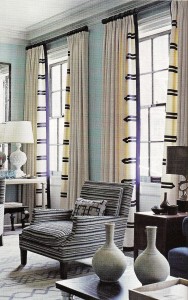
 I would like to know the standard drape length for 10′ ceilings, w/and w/out crown moldings. My window trim length is 84″. This is her dining room window. She only has a hutch that has height. We are using pole rodding with rings. I would appreciate your help, as I have this w/2 customers.
I would like to know the standard drape length for 10′ ceilings, w/and w/out crown moldings. My window trim length is 84″. This is her dining room window. She only has a hutch that has height. We are using pole rodding with rings. I would appreciate your help, as I have this w/2 customers.
Thanks, Judy @ Jake’s Home Decor Lebanon MO
 Thanks for the question. There is no standard drapery length. Each window and room is different- from design intent to proportions and challenges. With that said, here are some guidelines. First, custom drapery should not be mounted on the window frame. Typically, it should be at least 4″ above the frame. Second, depending on the window width and other considerations, mounting at the ceiling adds elegance and more formality. From what you have said, the trim to floor measure is 84″ and there is a 3′ space to ceiling. That might be too much for your customer. I would suggest mounting the rod at the same height as the hutch which eliminates an extra sight line or at least split the difference in the wall space from top of window to ceiling. I would also suggest that you sketch to scale to show customer before you proceed with order. If you go to the ceiling, you should consider an attached valance or panel swag on the panel for detail and interest that has a finished length at top of window.
Thanks for the question. There is no standard drapery length. Each window and room is different- from design intent to proportions and challenges. With that said, here are some guidelines. First, custom drapery should not be mounted on the window frame. Typically, it should be at least 4″ above the frame. Second, depending on the window width and other considerations, mounting at the ceiling adds elegance and more formality. From what you have said, the trim to floor measure is 84″ and there is a 3′ space to ceiling. That might be too much for your customer. I would suggest mounting the rod at the same height as the hutch which eliminates an extra sight line or at least split the difference in the wall space from top of window to ceiling. I would also suggest that you sketch to scale to show customer before you proceed with order. If you go to the ceiling, you should consider an attached valance or panel swag on the panel for detail and interest that has a finished length at top of window.
__________________________________________________________________________________________
 I am specifying a pair of draperies and top treatments. I have a bracket to bracket width measurement of 96 inches. The measurement from top of trim to the floor is 82 inches. I usually mount the rod approximately 4 inches above the trim. After hearing your instructions on height and width proportion, I realize there is a formula that I am missing that would make these draperies look better proportionately. Can you help me with that formula?
I am specifying a pair of draperies and top treatments. I have a bracket to bracket width measurement of 96 inches. The measurement from top of trim to the floor is 82 inches. I usually mount the rod approximately 4 inches above the trim. After hearing your instructions on height and width proportion, I realize there is a formula that I am missing that would make these draperies look better proportionately. Can you help me with that formula?
Mary Tischer
Expressions by Mary, Inc

Here is the short version of the guidelines based on golden proportions., ratios and fibonacci scale.:
Take the total length of your treatment (86 inches; I added for mounting the treatment up 4 inches from frame) and divide by 5 which equals 17 inches. Then and divide by 6 which equals 14 inches. The answers tell you that when mounting your treatment up 4″; the valance should be somewhere between 17″ – 14″ long. If it has a shaped hem then the long point most likely should be 17″ and the short point starts at 14″. (Note that a 3″ difference between the long point and the short point is the minimum to show a shape. ) Always sketch for design intent to see if this is the look you want and then tweak to architectural elements or obstructions, etc. If you don’t want that look or if there are other circumstances like the pattern repeat is large; then play with panel heights by raising the mounting height. Remember that will deepen the top treatment.
For future reference, take a page from graphic designers and get a proportion wheel. A wheel can help you translate photographic measurements into actual treatment sizes. Rowley sells them.
Deb Barrett


